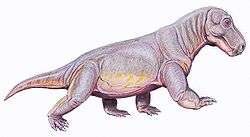Ulemosaurus
| Ulemosaurus Temporal range: Capitanian, 265–260 Ma | |
|---|---|
 | |
| Scientific classification | |
| Kingdom: | Animalia |
| Phylum: | Chordata |
| Order: | Therapsida |
| Suborder: | †Dinocephalia |
| Family: | †Tapinocephalidae |
| Genus: | †Ulemosaurus |
| Species: | †U. svijagensis |
| Binomial name | |
| Ulemosaurus svijagensis Rjabinin, 1938 | |
Ulemosaurus svijagensis was a dinocephalian synapsid that lived 265 to 260 million years ago, at Isheevo in Russian Tatarstan. It was a tapinocephalid, a group of bulky herbivores which flourished in the Middle Permian. Ulemosaurus and other tapinocephalians disappeared at the end of the Mid-Permian.
Description

Only several partial skeletons and skulls have been found. The skull bones are extremely dense: about 10 centimetres (4 in) at its thickest. This thickening is possibly related to head-butting behavior, as some researchers suggest. The species is considered a herbivore, but because the mandible is heavily constructed some palaeontologists consider it a carnivore, with the species being able to use muscle power to cut prey up with its incisors.
Classification
Ulemosaurus is a large Moschops-like form from Russia; it is probably similar enough to be included as a separate species of Moschops. Despite its advanced characteristics, it lived slightly before the Karoo forms, showing that the Moschopines, and indeed the Tapinocephalidae in general, had already attained their acme but early Capitanian time.
See also
Further reading
- Patricia Vickers-Rich and Thomas H. Rich, The Great Russian Dinosaurs, Guntar Graphics, 1993, p. 35. ISBN 0-7326-0503-2
- Riabinin, A. N., 1938. Vertebrate fauna from the Upper Permian deposits of the Sviaga basin: 1. A new Dinocephalian, Ulemosaurus sviagensi n. gen. n. sp: Ezheg. Muz. Akad. F. N. Chernysheva, v. 1, p. 4-40.
External links
- Taxonomy
- Dinocephalians
- Therapsida: Tapinocephalia: Tapinocephalidae
- Dinosulemosaurus
- Tapinocephalidae

